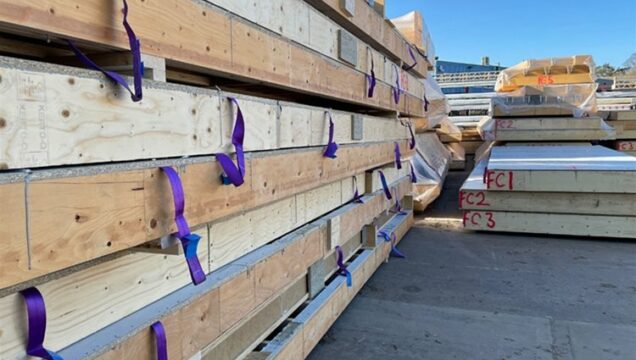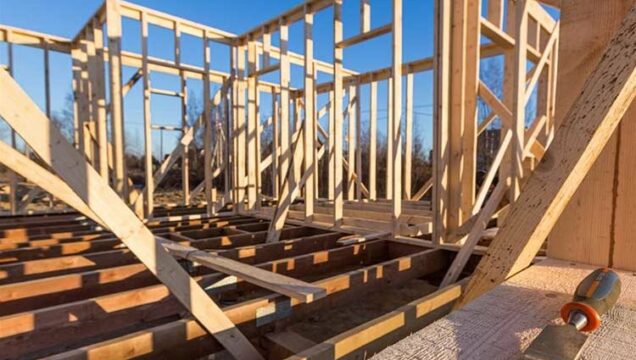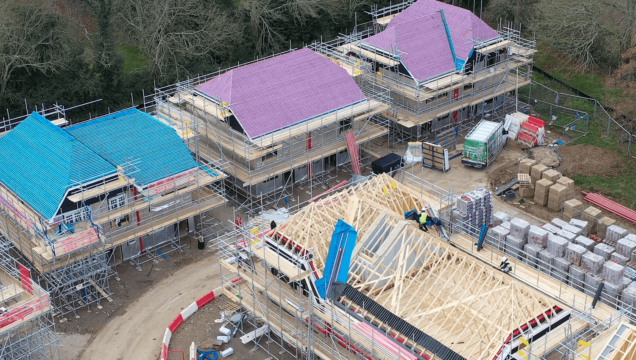

Panelised timber frame construction has gained traction in recent years as a more sustainable and innovative building method for the construction industry. More specifically for housing developers embarking on residential schemes, from a range of detached houses and apartments to large-scale social housing.
Among the distinct benefits of timber frame over masonry construction, offsite timber frame has many health and safety advantages for the construction of housing in the UK. It can significantly aid the housing crisis and government targets as it has a plentiful supply chain, is sustainable, affordable and build times are 30% quicker.
In this article, we’ll delve into its potential to enhance health and safety, the wellbeing of occupants and its environmental benefits.
//Improved Health & Safety On-Site
With timber frame construction and MMC, it is common practice for most of the elements to be manufactured off-site in a factory environment. First, they are accurately engineered and designed by experts before they are constructed and delivered on-site, ready to install. This means that buildings are designed to be built safely, and results in less work on site in variable conditions, reducing the risk of health and safety issues.
Walls, roofs and joists are all usually lifted into place using cranes which immediately reduces one of the biggest health and safety risks of working at height. At Pinewood Structures, we create project-specific Risk Assessment Method Statements (RAMS) to ensure work is carried out in a safe, careful and methodical way. We also instruct independent Health and Safety firms to inspect factories and sites that we work on to ensure our team are working in the safest environments.
Other ways in which timber frame improves health and safety on-site includes:
Structural Integrity & Safety
Structural integrity inevitably impacts the safety of a timber frame structure. All timber frame houses are specifically engineered in order to give developers and residents the best possible performance alongside the lightest possible structural members. Also, with Pinewood’s rigorous quality control measures, we can ensure precision and quality which reduces the risk of structural defects and strengthens its integrity.
Fire Safety
It’s a common misconception that timber is a fire risk. Timber frames are carefully detailed to ensure that best practice is used to protect structures both during construction and occupation. With the 16 steps to fire safety on timber construction sites, products used have full data sheets and fire testing data and reports to ensure that the latest products are used correctly.
Speed of Construction
By reducing project timelines, panelised construction reduces exposure to potential hazards on-site making it safer for workers. The speed of construction is due to the efficiency of MMC and the pace doesn’t compromise the structural integrity, as mentioned above.
//Better Health & Wellbeing
Indoor Air Quality
Did you know that timber’s natural properties actually contribute to a healthier indoor environment? Whilst reducing a development’s carbon emissions, it also has design flexibility, allowing the creation of an open environment to promote wellbeing. Plus, without the need for wet products, such as plastering and cement work, there is minimal release of volatile organic compounds (VOCs) promoting better indoor air quality.
Lower Sympathetic Nervous System (SNS)
Timber can affect us more than just regulating our living temperature; it can also impact us physically and mentally. It has been shown that wood can lower our sympathetic nervous system (SNS) which can ultimately reduce stress levels and blood pressure, leaving individuals feeling more positive and energised.
//Positive Sustainability & Environmental Impact
Timber is the only truly renewable resource, contributing to a circular economy and sustainable construction practices. It produces 40% less carbon than masonry construction as it requires less energy to construct and are built offsite. Also, MMC and offsite construction generates less waste compared to traditional masonry, especially when it is reused as biofuel to heat factories like we do.
At Pinewood Structures, we strive to reflect the sustainability values of timber frame construction throughout our entire operations. We regularly review our practice to make sure they are environmentally conscious and continuously endeavour to grow our decarbonisation strategies.
//Why Developers Should Use Pinewood Structures
As you can see, timber frame construction provides many benefits for the housing developments and their residents, but there are so many more advantages than this.
With our 40 years of industry experience, we have worked with a range of housing developers including alternatively funded housing, the build-to-rent sector and contractors working with housing associations.
If you’re interested in this forward-thinking solution for your next development, get in touch with us today to discuss your requirements.


